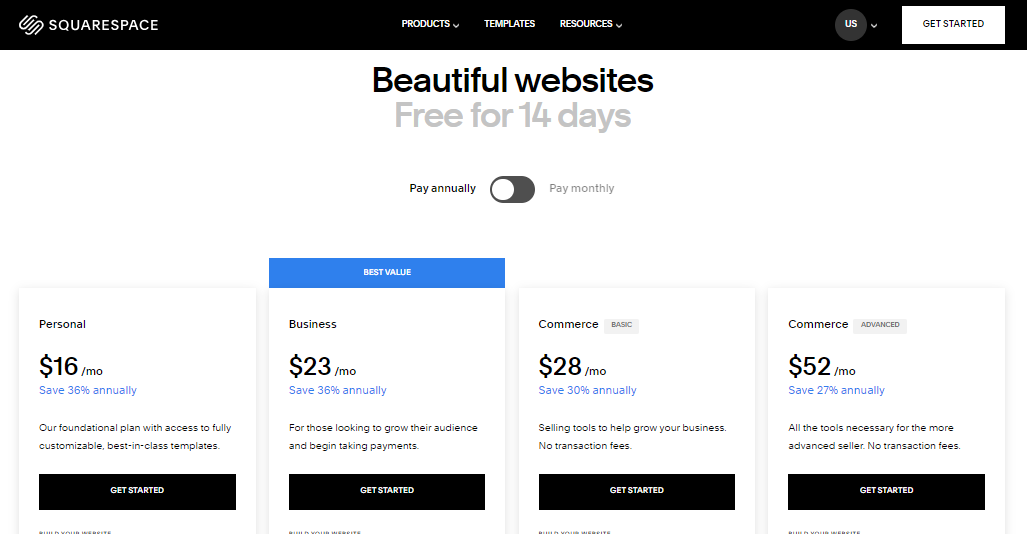Click here to visit Original posting

Squarespace is a top website builder known for its elegant designs and robust features. With over 100 premium, mobile-optimized templates, it’s a favorite for creatives and businesses seeking visually stunning, professional websites.
For
- Built-in email marketing
- Essential e-commerce features with most plans
- Lots of lovely, mobile-responsive templates
- Free trial with no credit card info required
- Helpful link in bio tool
- Free SSL certificate
- Helpful 24/7 customer support and well-supplied knowledgebase
- A solid set of features
Against
- Can't switch templates without starting from scratch
- No telephone support
- Low level of customization

GoDaddy Website Builder is a popular choice for beginners, offering a user-friendly interface and quick setup. With customizable templates and integrated marketing tools, it’s designed to help small businesses and entrepreneurs create functional websites with ease.Go
For
- 30-day free trial
- 24/7 phone and live chat support
- AI-powered tools for website optimization
- Easy-to-use editor
- Solid range of simple customizations
- Over 100 good-looking templates to choose from
- Marketing and SEO tools included
Against
- AI-generated sites lack creativity and individual touch
- Limited level of customization
- Ecommerce with top-tier plan only
- No app marketplace for additional integrations
Creating a website is easier and more affordable than ever before. From no-code website builders to finding cheap domains and hosting plans, it seems like you can do it all for a couple of bucks. But, among countless brands, two stand out. Both Squarespace and GoDaddy are well known as two of the best website builders on the market, but with many similar tools and features, it is no surprise potential customers often get confused about which one is best for them.
Squarespace primarily offers a drag-and-drop website builder, dynamic website templates, and even multiple products targetting specific businesses such as dedicated templates for sellers, Bio Sites, creator tools for freelancers/ influencers, and SEO tools for digital marketers.
GoDaddy's primary business is the sale of domains, and not very long ago, it started providing additional services like website building, logo making, and more. But this isn’t to say that GoDaddy isn’t a strong competitor in the website building space. In fact, in a short time, it has become one of the key players with powerful tools that are comparable to the likes of Squarespace.
In this guide, we take a look at the most important areas of website building and offer a comparison between what is offered by the two players. The goal isn’t to give a generic answer to ‘which is the best website builder’, but instead provide you with the information you need to make an informed decision on which platform best suits your unique needs and goals.
Squarespace vs GoDaddy: Pricing

Squarespace pricing is straightforward, starting with the Personal plan. For $16/month (billed annually) you get features like a custom domain, SSL security, unlimited bandwidth, and Squarespace AI.
If you need more, the Business plan for $23/month adds advanced website analytics, free invoices, promotional pop-ups, banners, and a nominal 3% transaction fee on sales. For ecommerce, the Basic Commerce plan at $27/month includes customer accounts, product waitlists, and low stock alerts and the Advanced Commerce plan adds advanced shipping, discounts, and abandoned cart recovery for $52/month.
You can also save on your Squarespace subscription by signing up for an annual plan over monthly billing and using one of the best Squarespace promo codes at checkout.

GoDaddy, on the other hand, starts with the Basic plan at $9.99/month, ideal for small businesses that need SSL, unlimited social media platforms alongside unified inbox and website chat. On top of this, the Standard plan adds additional marketing tools like built-in SEO and social posts for $11.99/month.
Next up, the Premium plan at $14.99/month includes all the benefits of the Standard plan, plus recurring appointments. Lastly, if you just want to build an online store, the Ecommerce plan at $24.99/month is the best choice as it covers all the essentials like product listings, shipping, and abandoned cart recovery.
My Verdict: Squarespace is a premium option with higher pricing, ideal for businesses and creatives needing strong design and e-commerce features. GoDaddy offers more affordable, simple plans, perfect for beginners or businesses looking for a quick and easy website setup.
Squarespace vs GoDaddy: Setup & page editor

Squarespace’s setup and editing process are both minimalist and visually appealing. With a Fluid Engine drag-and-drop editor, Squarespace offers real-time previews of your edits and even offers many AI features to improve your website. You get dedicated theme patterns, tons of templates distributed on an industry basis, and limited yet versatile font options to fulfill your brand’s persona. If you plan on running an online store, Squarespace has dedicated e-commerce themes and well-organized sections for payments, shopping carts, and products.

GoDaddy’s layout may be less visually appealing, but its editor is simpler than Squarespace's, particularly for non-technical users. With a guided walkthrough to set up your site, you can add pictures, design pages, etc., using the swipe-to-style editor both from your desktop or even your phone. Plus, GoDaddy Airo AI creates your website, logo, and more by just using details of your business. Likewise, once your ecommerce store is ready, you can upgrade to start selling and connect with top marketplaces like Instagram, Google, Etsy, eBay, Facebook, and Amazon.
My Verdict: Squarespace is perfect if you want a visually-driven, customizable setup, while GoDaddy is better for beginners who value ease of use and speed over advanced design and customization.
Squarespace vs GoDaddy: Ecommerce

Squarespace lets you send invoices and sell content like online courses, videos, blogs, memberships as well as physical products. Further, you can use your own domain for checkout and connect with different Point-Of-Sale (POS) systems, helping create a seamless experience for your customers.
If you want to go all in with your store, Squarespace provides product reviews for your customers, features for selling your products and services on Facebook and Instagram, limited availability labels, and abandoned cart recovery. On high-tier plans, you get advanced options for shipping, discounts, and access to Commerce APIs.

With the GoDaddy Ecommerce plan, you can create dedicated websites to sell products. Just integrate your online store to add products and services, set up payment methods, manage shipping options and return policies, warranties, and guarantees.
Plus, you can highlight featured products, integrate Square, PayPal, and Stripe, and keep subscribers informed about sales, coupon offers, and online events along with email marketing tools. GoDaddy also lets you customize your online store with WordPress and WooCommerce integration.
My Verdict: Both platforms have extensive ecommerce features and support flat-rate, calculated, and free shipping, along with a range of third-party app integrations. In a nutshell, consider Squarespace if you want a neatly designed and stunning-looking online store and GoDaddy if you’re a beginner on a tight budget who just wants to get started with a simple yet effective ecommerce website.
Squarespace vs GoDaddy: SEO tools
When it comes to SEO, both Squarespace and GoDaddy let you edit tags and meta descriptions, add image alt text, customize URLs, and access keyword support. But there are a few things to consider.
Squarespace site comes with a site map using the .xml format, so you don't need to create one manually. Squarespace also lets you add Meta Pixel & Ads for targeted advertising. Plus, you can explore keywords with time filters and access an SEO Checklist making optimizing your site a breeze..
On the other hand, GoDaddy has a step-by-step wizard that guides you through optimizing your homepage, and if you've used it before, you can revisit tasks to refine any page, blog post, or image. Similarly, you can track your site's performance using Google Analytics and return to optimize further as needed.
My Verdict: While Squarespace comes with an integrated sitemap and Meta Pixel for users who prefer simplicity, GoDaddy’s SEO wizard provides a more guided, step-by-step approach for beginners. Since both offer quite basic SEO tools, you can try their free trial to see which one suits your business better.
Squarespace vs GoDaddy: Verdict
Both Squarespace and GoDaddy are solid website builders, but they cater to different needs. GoDaddy is the cheaper and faster option, perfect for those who want to get online quickly without fussing over too many details. It’s great for beginners with its straightforward email marketing process and essential features at an affordable price. GoDaddy’s guided approach is ideal for those who want to get things up and running with minimal hassle.
Squarespace, while more expensive, excels in aesthetics and creative control. Its beautiful templates, drag-and-drop editor, and powerful tools like built-in SEO and automatic sitemaps make it a top choice for creatives, artists, and anyone wanting to build a visually stunning online presence. A generous student discount also makes it a great option for young entrepreneurs and creators looking to save while building something professional.
In the end, if speed, simplicity, and cost are your main concerns, GoDaddy wins. But if you're after elegance, customization, and appealing aesthetics, Squarespace is a better choice.